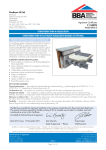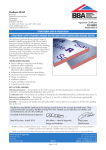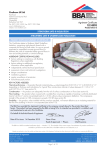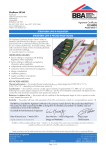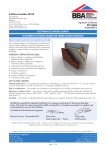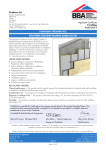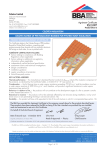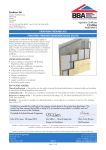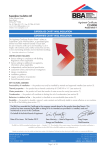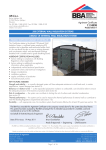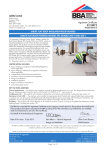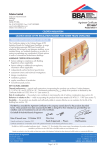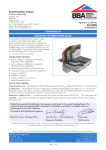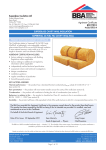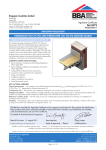Download Thin-R TR/BGM BBA Cert PDF
Transcript
Xtratherm UK Ltd APPROVAL INSPECTION TESTING CERTIFICATION Park Road Holmewood Industrial Park Holmewood Chesterfield Derbyshire S42 5UY Tel: 0371 222 1033 Fax: 0371 222 1044 TECHNICAL APPROVALS FOR CONSTRUCTION Agrément Certificate 11/4878 e-mail: [email protected] website: www.xtratherm.com Product Sheet 2 XTRATHERM THIN-R INSULATION XTRATHERM THIN-R FLAT ROOF INSULATION BOARD (XT/FR-MG/BG) PRODUCT SCOPE AND SUMMARY OF CERTIFICATE This Certificate relates to Xtratherm Thin-R Flat Roof Insulation Board (XT/FR-MG/BG), a rigid thermoset polyisocyanurate board with a mineral coated glassfibre facing on one side and a composite bitumen/glassfibre facing on the other face, for use as a thermal insulation layer and to create or improve falls on limited access concrete, metal or timber flat roof decks. It is for use in conjunction with a vapour control layer and adhesively bonded or mechanically fixed roof waterproofing membranes in domestic and non-domestic buildings. AGRÉMENT CERTIFICATION INCLUDES: • factors relating to compliance with Building Regulations where applicable • factors relating to additional non-regulatory information where applicable • independently verified technical specification • assessment criteria and technical investigations • design considerations • installation guidance • regular surveillance of production • formal three-yearly review. KEY FACTORS ASSESSED Thermal performance — the product has declared thermal conductivities (λ90/90 value) ranging from 0.024 W·m–1·K–1 to 0.027 W·m–1·K–1 depending on thickness (see section 5). Condensation risk — the product can contribute to limiting the risk of surface condensation (see section 6). Strength and stability — when installed on suitable substrates using appropriate adhesive and/or mechanical fixing methods, the product can adequately transfer maintenance traffic loads and wind loads to the roof deck (see section 7). Behaviour in relation to fire — the overall fire rating of any roof containing the product will depend on the type of deck and the nature of the roof waterproof covering (see section 8). Durability — the product, when used as thermal insulation in the roof system described in this Certificate, will have a life at least as long as that of a roof waterproofing covering (see section 10). The BBA has awarded this Agrément Certificate to the company named above for the product described herein. This product has been assessed by the BBA as being fit for its intended use provided it is installed, used and maintained as set out in this Certificate. On behalf of the British Board of Agrément Date of First issue: 15 November 2011 Sean Moriarty Greg Cooper Head of Approvals — Physics Chief Executive The BBA is a UKAS accredited certification body — Number 113. The schedule of the current scope of accreditation for product certification is available in pdf format via the UKAS link on the BBA website at www.bbacerts.co.uk Readers are advised to check the validity and latest issue number of this Agrément Certificate by either referring to the BBA website or contacting the BBA direct. British Board of Agrément Bucknalls Lane Garston, Watford Herts WD25 9BA ©2011 Page 1 of 12 tel: 01923 665300 fax: 01923 665301 e-mail: [email protected] website: www.bbacerts.co.uk Regulations In the opinion of the BBA, Xtratherm Thin-R Flat Roof Insulation Board (XT/FR-MG/BG), if used in accordance with the provisions of this Certificate, will meet or contribute to meeting the relevant requirements of the following Building Regulations: The Building Regulations 2010 (England and Wales) Requirement: A1 Loading Comment: Requirement: B4(2) External fire spread Comment: Requirement: C2(c) Resistance to moisture Comment: Requirement: L1(a)(i) Conservation of fuel and power The product is acceptable. See section 7.1 of this Certificate. Roofs incorporating the product can meet this Requirement. See section 8.2 of this Certificate. The product will contribute to a roof meeting this Requirement. See sections 6.1 and 6.4 of this Certificate. Comment: The product can meet or contribute to a roof meeting this Requirement. See sections 5.2 and 5.3 of this Certificate. Requirement: Regulation 7 Materials and workmanship Comment: The product is an acceptable material. See section 10 and the Installation part of this Certificate. The Building (Scotland) Regulations 2004 (as amended) Regulation: 8(1) Regulation: Standard: 9 1.1 2.8 3.15 6.1(b) 6.2 7(a)(b) Statement of sustainability The product can contribute to meeting the relevant Requirements of Regulation 9, Standards 1 to 6 and therefore will contribute to a construction meeting a bronze level of sustainability as defined in this Standard. In addition the product can contribute to a construction meeting a higher level of sustainability as defined in this Standard, with reference to clauses 7.1.4(2) Aspect 1(2), 7.1.6(2) Aspect 1(2) and 7.1.7(2) Aspect 1(2). See section 5.2 of this Certificate. Comment: Regulation: Carbon dioxide emissions Building insulation envelope The product can contribute to satisfying the requirements of these Standards, with reference to clauses, or parts of 6.1.2(2), 6.1.6(1), 6.2.1(1)(2), 6.2.3(1), 6.2.4(2), 6.2.5(2), 6.2.6(1), 6.2.7(1), 6.2.8(1)(2), 6.2.9(1)(2), 6.2.10(1)(2), 6.2.11(1)(2), 6.2.12(2) and 6.2.13(1)(2). See sections 5.2 and 5.3 of this Certificate. Comment: Standard: Condensation The product will contribute to a roof meeting this Standard, with reference to clauses 3.15.1(1)(2), 3.15.3(1)(2), 3.15.4(1)(2), 3.15.5(1)(2) and 3.15.6(1)(2). See sections 6.1 and 6.5 of this Certificate. Comment: Standard: Standard: Spread from neighbouring buildings Roofs incorporating the product can meet this Standard, with reference to clauses 2.8.1(1)(2). See section 8.2 of this Certificate. Comment: Standard: Building Standards — construction Structure The product is acceptable, with reference to clauses 1.1.1(1)(2), 1.1.2(1)(2) and 1.1.3(1)(2). See section 7.1 of this Certificate. Comment: Standard: Fitness and durability of materials and workmanship The product can contribute to a construction satisfying this Regulation. See section 10 and the Installation part of this Certificate. Comment: 12 Building standards — conversions Comments made in relation to the product under Regulation 9 Standards 1 to 6 also apply to this Regulation, with reference to clause 0.12.1(1)(2) and Schedule 6(1)(2). Comment: (1) Technical Handbook (Domestic). (2) Technical Handbook (Non-Domestic). The Building Regulations (Northern Ireland) 2000 (as amended) Regulation: B2 Fitness of materials and workmanship Comment: Regulation: C5 Condensation Comment: Regulation: D1 Stability Comment: Regulation: E5(b) External fire spread Comment: Regulation: Regulation: F2(a)(i) F3(2) Conservation measures Target carbon dioxide Emissions Rate Comment: The product is acceptable. See section 10 and the Installation section of this Certificate. The product will contribute to a roof meeting this Regulation. See section 6.1 of this Certificate. The product is acceptable. See section 7.1 of this Certificate. Roofs incorporating the product can meet this Regulation. See section 8.2 of this Certificate. Roofs incorporating the product can satisfy or contribute to satisfying this Regulation. See sections 5.2 and 5.3 of this Certificate. Page 2 of 12 Construction (Design and Management) Regulations 2007 Construction (Design and Management) Regulations (Northern Ireland) 2007 Information in this Certificate may assist the client, CDM co-ordinator, designer and contractors to address their obligations under these Regulations. See section: 2 Delivery and site handling (2.3) of this Certificate. Additional Information NHBC Standards 2011 NHBC accepts the use of Xtratherm Thin-R Flat Roof Insulation Board (XT/FR-MG/BG), when installed and used in accordance with this Certificate, in relation to NHBC Standards, Chapter 7.1 Flat roofs and balconies. Technical Specification 1 Description 1.1 Xtratherm Thin-R Flat Roof Insulation Board (XT/FR-MG/BG) is a rigid thermoset polyisocyanurate insulation board manufactured using CFC/HCFC free materials, incorporating a mineral coated glassfibre facing on one side and a composite bitumen/glassfibre facing on the other face. 1.2 The product has the nominal characteristics of: Length and width (mm) 1200 x 600, 1200 x 1200 and 2400 x 1200 Thickness (mm) 50 — 165 (in 5 mm increments) Compressive strength at 10% compression (kPa) 150 Density (kg·m–3) 30 Edge profile Square, rebated 1.3 The product is also available in a tapered version for falls of 1:120, 1:80 and 1:60 (1200 mm by 1200 mm). 1.4 Quality control checks are carried out during the manufacturing process and on the finished product. 1.5 Ancillary items used with the product are: • waterproofing membrane • vapour control layer (VCL) • fixings — incorporating countersunk washer. 2 Delivery and site handling 2.1 The product is delivered to site shrink-wrapped in polythene packs containing a label with the product description and characteristics, the manufacturer’s name, and the BBA identification mark incorporating the number of this Certificate. 2.2 It is essential that the product is stored such that it is raised off the ground, is inside or under cover on a flat, dry, level surface in a well-ventilated area. The product must be protected from rain, snow and prolonged exposure to sunlight. Boards that have been allowed to get wet should not be used. Damaged boards must not be used. Nothing should be stored on top of boards. 2.3 The product must not be exposed to a naked flame or other ignition sources. The product must not be exposed to solvents or other chemicals. Assessment and Technical Investigations The following is a summary of the assessment and technical investigations carried out on Xtratherm Flat Roof Insulation Board (XT/FR-MG/BG). Design Considerations 3 General 3.1 Xtratherm Thin-R Flat Roof Insulation Board (XT/FR-MG/BG) is suitable for use as a thermal insulation layer on concrete, timber or metal flat roofs, with access limited to maintenance only. 3.2 Decks should be designed in accordance with the relevant clauses of either BS 6229 : 2003 or BS 8217 : 2005 and, where appropriate, the NHBC Standards 2011, Chapter 7.1, Section 4. 3.3 Roofs should incorporate an effective VCL below the boards. Page 3 of 12 3.4 The product is for use with one of the following waterproofing specifications: • built-up bitumen felt to BS 8747 : 2007 laid in accordance with BS 8217 : 2005 • other bitumen waterproofing systems which are the subject of a current Agrément Certificate, laid in accordance with, and within the limitations imposed by that Certificate • mechanically (1) fixed single-ply waterproofing membranes, such as PVC, CSM, CPE, FPO (including TPO), EVA, PIB and EPDM, which are the subject of a current Agrément Certificate, laid in accordance with, and within, the limitations imposed by that Certificate • mastic asphalt (1) laid in accordance with BS 8218 : 1998. (1) Mineral coated glassfibre facing (MG) side facing up. 3.5 Limited access roofs are defined for the purpose of this Certificate as those roofs subject only to pedestrian traffic for maintenance of the roof covering and cleaning of gutters, etc (see also section 7.11). 3.6 Flat roofs are defined for the purpose of this Certificate as those roofs having a minimum finished fall of 1:80 and a maximum 1:6 as defined in BS 6229 : 2003. 3.7 For design purposes on flat roofs, twice the minimum finished fall should be assumed, unless a detailed analysis of the roof is available, including overall and local deflections, direction of falls etc. 3.8 Tapered boards may be used where appropriate to achieve the minimum finished falls required. 4 Practicability of installation The product is designed to be installed by a competent general builder, or a contractor, experienced with this type of product. 5 Thermal performance 5.1 Calculations of thermal transmittance (U value), should be carried out in accordance with BS EN ISO 6946 : 2007 and BRE Report (BR 443 : 2006) Conventions for U-value calculations, using the declared thermal conductivity (λ90/90 value) given in Table 1. Table 1 Thermal conductivity (λ90/90 values) Insulation thickness (mm) Thermal conductivity (W·m–1·K–1) <80 0.027 80 to 120 0.025 >120 0.024 5.2 The U value of a completed roof will depend on the thickness of insulation used, the number and type of fixings and the insulating value of other roof components/layers. Example U values of roofs incorporating the product are shown in Tables 2 to 4. Table 2 Example U values for a fully adhered system Insulation thickness(1) (mm) U value (W·m–2·K–1) Concrete (2) Timber (3) Metal(4) 150 145 125 120 95 145 135 125 110 90 155 145 130 120 95 0.15 0.16 0.18 0.20 0.25 (1) Nearest available thickness. (2) 150 mm concrete decking 1.33 W·m–1·K–1, VCL, 1.5 mm waterproofing membrane. (3) 12.5 mm plasterboard, 150 mm timber joists (12.5%)/air cavity (87.5%), 18 mm plywood decking, VCL, 1.5 mm waterproofing membrane. (4) Metal deck (not included in calculation), VCL, 1.5 mm waterproofing membrane. Page 4 of 12 Table 3 Example U values for constructions with stainless steel fixings Insulation thickness(1) (mm) U value (W·m–2·K–1) Concrete (2)(3) Timber (2)(4) Metal(2)(5) 165 155 140 125 105 155 145 130 120 95 – 160 140 125 105 0.15 0.16 0.18 0.20 0.25 (1) Nearest available thickness. (2) Includes 5.55 stainless steel insulation fixings per m2, with a 3.55 stainless steel waterproofing fixings per m2, with a 4.8 mm cross sectional diameter. (3) 150 mm concrete decking 1.33 W·m–1·K–1, VCL, 1.5 mm waterproofing membrane. (4) 12.5 mm plasterboard, 150 mm timber joists (12.5%)/air cavity (87.5%), 18 mm plywood decking, VCL, 1.5 mm waterproofing membrane. (5) Metal deck (not included in calculation), VCL, 1.5 mm waterproofing membrane. Table 4 Example U values for constructions with galvanized steel fixings Insulation thickness(1) (mm) U value (W·m–2·K–1) Concrete (2)(3) Timber (2)(4) Metal(2)(5) 160 145 120 145 130 95 165 145 110 0.18 0.20 0.25 (1) Nearest available thickness. (2) Includes 5.55 galvanized steel insulation fixings per m2 and 3.55 galvanised steel waterproofing fixings per m2, with a 4.8 mm cross sectional diameter. (3) 150 mm concrete decking 1.33 W·m–1·K–1, VCL, 1.5 mm waterproofing membrane. (4) 12.5 mm plasterboard, 150 mm timber joists (12.5%)/air cavity (87.5%), 18 mm plywood decking, VCL, 1.5 mm waterproofing membrane. (5) Metal deck (not included in calculation), VCL, 1.5 mm waterproofing membrane. 5.3 The product can contribute to maintaining continuity of thermal insulation at junctions between elements and openings. For Accredited Construction Details the corresponding psi values in BRE Information Paper IP1/06 Assessing the effects of thermal bridging at junctions and around openings, Table 3 may be used in carbon emission calculations in Scotland and Northern Ireland. Detailed guidance for other junctions and on limiting heat loss by air infiltration can be found in: England and Wales — Approved Documents to Part L and for new thermal elements to existing buildings, Accredited Construction Details (version 1.0). See also SAP 2009 Appendix K and the iSBEM User Manual for new-build Scotland — Accredited Construction Details (Scotland) Northern Ireland — Accredited Construction Details (version 1.0). 6 Condensation risk Interstitial condensation 6.1 Roofs will adequately limit the risk of interstitial condensation when they are designed and constructed in accordance with BS 5250 : 2002, Section 8.4 and Appendix D and BRE Report (BR 262 : 2002) Thermal insulation: avoiding risks in England and Wales. 6.2 For the purposes of assessing the risk of interstitial condensation, the insulation core vapour resistivity may be taken as approximately 344 MN·s·g–1·m–1 and a resistance value of 258 MN·s·g–1·m–1 for the bitumen facing. 6.3 To minimise moisture entering the roof an effective VCL such as 0.25 mm minimum thickness polyethylene should be used with sealed and lapped joints and be turned up around the insulation and bonded to the weatherproofing finish. Surface condensation 6.4 Roofs will adequately limit the risk of surface condensation when the thermal transmittance (U value) does not exceed 0.35 W·m–2·K–1 at any point and the junctions with other elements are designed in accordance with section 5.3. 6.5 Roofs will adequately limit the risk of surface condensation when the thermal transmittance (U value) does not exceed 1.2 Wm–2·K–1 at any point. Guidance may be obtained from BS 5250 : 2002, Section 8 and BRE Report (BR 262 : 2002). Page 5 of 12 7 Strength and stability 7.1 When installed on suitable flat roof decks, using appropriate fixings and/or adhesive, the product can adequately transfer maintenance traffic loads and negative and positive (suction and pressure) wind loads to the roof deck. 7.2 The roof construction or immediate substrate to which the product is fixed must be structurally sound and have sufficient strength and stability, to resist all dead, imposed and wind loads. It must also have adequate resistance to the pull-out forces created by the wind forces acting on the specified fixings used. 7.3 The suitability of the roof construction, and in particular the immediate substrate, to accept the adhesive bond and mechanical fixing must be checked before installation. Mechanical fixings must be checked before installation by carrying out in-situ pull-out or pull-through testing to determine the minimum safe working load the fixings can resist. The advice of the Certificate holder should also be sought in respect of suitable mechanical fixings. 7.4 The type and number of fixings will depend on the roof construction and location; the Certificate holder’s advice should be sought in this respect. The Certificate holder recommends a minimum number of fixings per board size, see section 12.15. 7.5 All design analysis must be in accordance with British or European Standards relevant to the construction. The requirement for fixings to suit the wind uplift requirements for the particular site should be assessed in accordance with BS 6399-2 : 1997 or BS EN 1991-1-4 : 2005. All calculations should be approved by a competent person. 7.6 Each fixing must incorporate a head or washer which is a minimum of 75 mm diameter if round or 75 mm by 75 mm if square. Fixings installed along the edges or at corners of the product should be installed between 50 mm to 150 mm from the board edge (210 mm for tapered boards). 7.7 For adhesive application of the insulation product, the substrate must be free of dust, dry and installation should be in accordance with the instructions of the adhesive manufacturer. The surface of the substrate must have sufficient cohesive strength to resist the calculated wind load acting upon the structure. 7.8 When adhering is the chosen method for the insulation or waterproofing, adhesion between the insulation product and VCL and between the product and overlay must be adequate to resist the effects of wind suction and thermal cycling likely to be experienced under normal conditions. In areas where high wind speeds can be expected, additional mechanical fixings should be considered and the advice of a suitably qualified Engineer should be sought as to the method of fixing as defined in the relevant clauses of BS 6399-2 : 1997 and BS EN 1991-1-4 : 2005. 7.9 Roof waterproof covering systems (see section 3.4 for suitable types) must be applied in accordance with the relevant Agrément Certificates or manufacturers guidance. 7.10 For design purposes, the product may be assumed to have an allowable compressive strength of 150 kPa at 10% compression. 7.11 The product has not been assessed for use with permanent distributed or concentrated loads, such as air conditioning units, mechanical plants, water tanks, etc. Such loads should be supported directly on the roof construction. The product is not suitable when permanent roof access is required. 7.12 When profiled decking is used, the product will need to span across the ribs. Maximum permissible spans between ribs for product thicknesses are shown in Table 5. Table 5 Maximum clear span Maximum clear span (mm) < 75 > 75 > 100 > 125 > 150 > 175 > 200 > 225 Minimum roofboard thickness (mm) 25 30 35 40 45 50 55 60 100 125 150 175 200 225 250 7.13 When maintenance is required to the roof waterproofing, protective boarding should be laid over the roof surface to avoid concentrations of load. 8 Behaviour in relation to fire 8.1 The fire rating of any roof containing the product will depend on the type of deck and the nature of the roof waterproof covering. 8.2 When tested in accordance with BS 476-3 : 2004, a fully bonded system comprising 0.7 mm thick profiled metal deck, a layer of a polythene VCL, a 100 mm thick board with the composite bitumen/glassfibre facer facing up, bitumen base layer, reinforced bitumen underlay and a bitumen cap sheet with mineral chippings, achieved an EXT.F.AA rating (Low vulnerability in Scotland) rating and is acceptable less than 6 m from a relevant boundary. Page 6 of 12 8.3 The designation of the roof covering must meet or satisfy the requirements of the national Building Regulations, thus: England and Wales — Approved Document B, sections 10 and 14 of volumes 1 and 2 respectively. Notional designations of some common roof coverings are given in Appendix A, Table A5, of the Approved Document B volumes 1 and 2 Scotland — Mandatory Standards 2.8, clause 2.8.1(1)(2) (1) Technical Handbook (Domestic). (2) Technical Handbook (Non-Domestic). Northern Ireland — Technical Booklet E, section 4. If, on flat roofs, the waterproof covering is protected by one of the surface finishes defined in Table 4.6 of Technical Booklet E, the roof is deemed to be of designation AA. 8.4 The designation of other specifications, eg when used on combustible substrates, should be confirmed by: England and Wales — test or assessment in accordance with Clause 6 of Appendix A of Approved Document B volumes 1 and 2 Scotland — test to conform to clauses 2.C(1) and 2.F(2) (1) Technical Handbook (Domestic). (2) Technical Handbook (Non-Domestic). Northern Ireland — test or assessment by a UKAS accredited laboratory, or an independent consultant with appropriate experience. 9 Maintenance The product, once installed does not require any regular maintenance and has suitable durability provided the roof waterproof layers are inspected and maintained at regular intervals (see section 10), therefore, maintenance is not required. 10 Durability The product is rot-resistant and durable, and will have a life at least as long as that of the roof waterproof covering. Installation 11 General 11.1 Xtratherm Thin-R Flat Roof Insulation Board (XT/FR-MG/BG) must be installed in accordance with the Certificate holder’s instructions and BS 6229 : 2003, BS 8217 : 2005, or the relevant Agrément Certificate, depending on the waterproofing to be applied. 11.2 Care should be taken to ensure the deck is graded to the correct fall, is dry, clean and free from any projections or gaps. 11.3 If the product is tapered and it is to be effective in providing a uniform fall it is essential that the structural deck is true and even. Any hollows, depressions, backfalls, found in the roof deck, eg must be rectified prior to laying the insulation. 11.4 For both mechanically and adhesively fixed systems, the suitability of the substrate deck to accept an adhesive bond or mechanical fixing must be checked prior to the work commencing. 11.5 The deck to which the VCL is to be applied must be level, dry, sound, and if bonded, free from dust and grease and other defects which may impair the bond. For adhered systems, all deck joints should be taped and, where necessary, the deck coated with bitumen primer to BS 3416 : 1991. 11.6 On multi-storey buildings or in areas subject to high wind loads, additional mechanical fixings may be required and the advice of the Certificate holder should be sought on any limitations of use. 11.7 The mechanical fixing frequency and pattern should be predetermined in accordance with the Certificate holder’s instructions and the relevant clauses of BS 6399-2 : 1997 or BS EN 1991-1-4 : 2005. Each fixing should incorporate a minimum of 75 mm diameter circular plate countersunk washer or a 75 mm by 75 mm square washer, which must not restrain more than one board. 11.8 To prevent moisture being trapped on, or in the insulation it is essential to: • protect the product during laying, before the application of the roof waterproofing, or to lay the roof covering at the same time as laying the product. However if the product is accidentally wetted, it must not be used • the product should be installed only when the ambient temperature is above 5ºC to prevent condensation. 11.9 The product can be cut with a sharp knife or fine-toothed saw to fit around projections through the roof. 11.10 The product is for use with the waterproofing membranes specified in section 3.4 that are laid in accordance with the relevant British Standard or subject of a current Agrément Certificate laid in accordance with, and within, the limitations imposed by that Certificate. 11.11 Once installed, access to the roof should be restricted in accordance with section 3.5. Page 7 of 12 12 Procedure General 12.1 The number of mechanical fixings required to fix the product will vary depending on the geographical location of the building, the topographical data, and height and width of the roof concerned etc. 12.2 The requirements for an additional number of fixings above those specified in section 12.14 should be assessed in accordance with BS 6399-2: 1997 or BS EN 1991-1-4 : 2005. Timber decks (eg tongue-and-groove boards, plywood) 12.3 A VCL is nailed to the deck, in accordance with BS 8217 : 2005. Laps of 150 mm are sealed using the appropriate grade of bitumen, a polyurethane adhesive or a suitable solvent based adhesive in accordance with BS 8217 : 2005. 12.4 The VCL should be turned up around the insulation and sealed to the waterproof finish at all edges and penetrations such as roof lights. Advice may be sought from the Certificate holder. 12.5 Hot bitumen adhesive or a polyurethane(1) adhesive or a suitable solvent-based(1) adhesive is applied over the VCL and the roofing boards are fully embedded into it, in a brick bonded pattern. (1) Mineral coated glassfibre facing (MG) side facing down. 12.6 When using non-bituminous waterproofing systems or adhesives, all board joints and edges should be sealed with 50 mm wide aluminium foil adhesive tape, prior to the application of the adhesive system and roof waterproofing membrane. Concrete decks 12.7 Before applying the VCL, an appropriate levelling screed should be applied where necessary and, if adhering the VCL and insulation boards, the whole deck treated with a suitable primer. The advice of the Certificate holder should also be sought in respect of a suitable primer. 12.8 For adhered systems, the VCL is fully bonded with hot bitumen, a polyurethane adhesive or a suitable solvent based adhesive and the laps sealed, and the boards applied in the manner described for timber decks (see section 12.4 to 12.6). Metal decks 12.9 If adhering the VCL and insulation product, the deck should be prepared and treated with a suitable primer before applying the VCL. The advice of the Certificate holder should also be sought in respect of a suitable primer. 12.10 For adhered systems a reinforced VCL is fully bonded, using a polyurethane adhesive or a suitable solventbased adhesive, to the metal deck and the product is applied in the manner described for timber decks (see section 12.5 and 12.6). 12.11 The product is laid with the long edges at right angles to the ribs and all board ends must be fully supported on a rib. 12.12 The thickness of the roof board used depends on the width of the rib openings of the metal deck as indicated in Table 6, section 7.12. Mechanical fixings 12.13 The product can be secured to concrete, metal and timber decks by means of mechanical fixings. 12.14 A 0.25 mm thick polythene VCL should be laid, with 150 mm sealed laps. The VCL should be turned up around the insulation and sealed to the waterproof finish at all edges and penetrations such as roof lights. Advice should be sought from the Certificate holder. 12.15 The product is laid over the VCL in a brick bonded pattern. On profiled metal decks, the product is secured to the deck with a minimum of four or six or eleven mechanical fixings placed within the individual board area (1200 mm by 600 mm), (1200 mm by 1200 mm) and (2400 mm by 1200 mm) respectively, sited between 50 mm and 150 mm from all edges (see Figures 1 to 3). A minimum of six fixings per 1200 mm by 1200 mm tapered boards are recommended, sited 210 mm from all edges (see Figure 4). Countersunk washers with circular plates of at least 75 mm diameter or 75 mm by 75 mm square should be used with each fixing. The requirement of additional fixings assessed in accordance with BS 6399-2 : 1997 or BS EN 1991-1-4 : 2005. Page 8 of 12 Figure 1 Fixing layout 1200 mm by 600 mm board — minimum fixing numbers 50 - 150 50 - 150 All dimensions in mm Figure 2 Fixing layout 1200 mm by 1200 mm board — minimum fixing numbers 50 - 150 50 - 150 600 400 All dimensions in mm Page 9 of 12 Figure 3 Fixing layout 2400 mm by 1200 mm board — minimum fixing numbers 50 - 150 50 - 150 600 400 All dimensions in mm Figure 4 Fixing layout 1200 mm by 1200 mm tapered board — minimum fixing numbers 210 210 600 400 All dimensions in mm Page 10 of 12 Weatherproofing (all systems) 12.16 The waterproofing system should be applied above the insulation product in accordance with section 3.4. Technical Investigations 13 Tests Tests were carried out by the BBA on Xtratherm Thin-R Flat Roof Insulation Board (XT/FR-MG) and the results assessed to determine: • • • • • • • • • • • behaviour under variations in temperature (unrestrained) behaviour under distributed load and increased temperature effect of concentrated load on cantilevered parts bowing under the effect of a thermal gradient behaviour on exposure to moisture tensile strength perpendicular to faces wind uplift density compressive strength dimensional stability in built-up roofing (Bitumen pour test) dimensional stability under specified temperature and humidity conditions. 14 Investigations 14.1 An assessment was made of the results of test data relating to: • dimensional stability with temperature • effect of concentrated load under a free span • fire rating • thermal conductivity (fresh and aged). 14.2 An assessment of the risk of interstitial condensation was made. 14.3 An assessment was made of typical constructions which achieve the design U values. Bibliography BS 476-3 : 2004 Fire tests on building materials and structures — Classification and method of test for external fire exposure to roofs BS 3416 : 1991 Specification for bitumen based coatings for cold application, suitable for use in contact with potable water BS 5250 : 2002 Code of practice for control of condensation in buildings BS 6229 : 2003 Flat roofs with continuously supported coverings — Code of practice BS 6399-2 : 1997 Loading for buildings — Code of practice for wind loads BS 8217 : 2005 Reinforced bitumen membranes for roofing — Code of practice BS 8218 : 1998 Code of practice for mastic asphalt roofing BS 8747 : 2007 Reinforced bitumen membranes (RBMs) for roofing — Guide to selection and specification BS EN 1991-1-4 : 2005 Eurocode 1 : Actions on structures — General actions — Wind actions BS EN ISO 6946 : 2007 Building components and building elements — Thermal resistance and thermal transmittance — Calculation method Page 11 of 12 Conditions of Certification 15 Conditions 15.1 This Certificate: • relates only to the product/system that is named and described on the front page • is issued only to the company, firm, organisation or person named on the front page — no other company, firm, organisation or person may hold or claim that this Certificate has been issued to them • is valid only within the UK • has to be read, considered and used as a whole document — it may be misleading and will be incomplete to be selective • is copyright of the BBA • is subject to English Law. 15.2 Publications, documents, specifications, legislation, regulations, standards and the like referenced in this Certificate are those that were current and/or deemed relevant by the BBA at the date of issue or reissue of this Certificate. 15.3 This Certificate will remain valid for an unlimited period provided that the product/system and its manufacture and/or fabrication, including all related and relevant parts and processes thereof: • are maintained at or above the levels which have been assessed and found to be satisfactory by the BBA • continue to be checked as and when deemed appropriate by the BBA under arrangements that it will determine • are reviewed by the BBA as and when it considers appropriate. 15.4 The BBA has used due skill, care and diligence in preparing this Certificate, but no warranty is provided. 15.5 In issuing this Certificate, the BBA is not responsible and is excluded from any liability to any company, firm, organisation or person, for any matters arising directly or indirectly from: • the presence or absence of any patent, intellectual property or similar rights subsisting in the product/system or any other product/system • the right of the Certificate holder to manufacture, supply, install, maintain or market the product/system • individual installations of the product/system, including their nature, design, methods, performance, workmanship and maintenance • any works and constructions in which the product/system is installed, including their nature, design, methods, performance, workmanship and maintenance • any loss or damage, including personal injury, howsoever caused by the product/system, including its manufacture, supply, installation, use, maintenance and removal • any claims by the manufacturer relating to CE marking. 15.6 Any information relating to the manufacture, supply, installation, use, maintenance and removal of this product/ system which is contained or referred to in this Certificate is the minimum required to be met when the product/system is manufactured, supplied, installed, used, maintained and removed. It does not purport in any way to restate the requirements of the Health and Safety at Work etc. Act 1974, or of any other statutory, common law or other duty which may exist at the date of issue or reissue of this Certificate; nor is conformity with such information to be taken as satisfying the requirements of the 1974 Act or of any statutory, common law or other duty of care. British Board of Agrément Bucknalls Lane Garston, Watford Herts WD25 9BA ©2011 Page 12 of 12 tel: 01923 665300 fax: 01923 665301 e-mail: [email protected] website: www.bbacerts.co.uk












